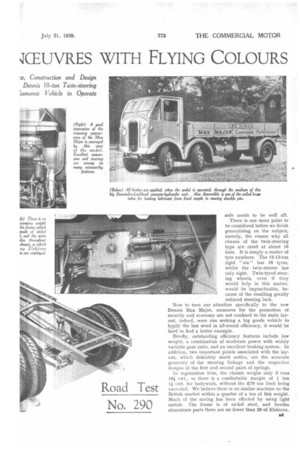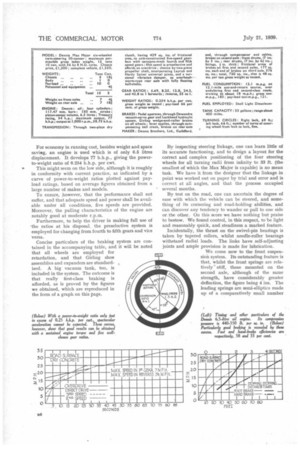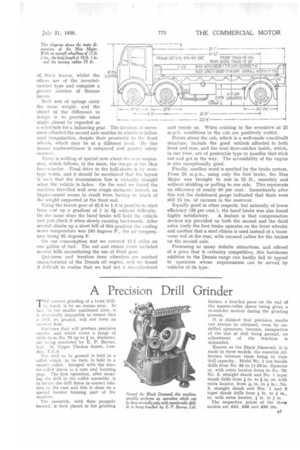MAX MAJOR COMES THROUGH 11
Page 38

Page 39

Page 40

Page 41

If you've noticed an error in this article please click here to report it so we can fix it.
4CEUVRES WITH FLYING COLOURS
Thorough Investigation of Indicates that the Recently Six-wheeler Should be a 1
:e, Construction and Design Dennis 10-ton Twin-steering :conornic Vehicle to Operate
SECURITY and economy result from the use, on a rigid six-wheeler, of two steering axles. This arrangement avoids the disregard of a simple mechanical fact, which is the cause of a theoretic fault on all other types of rigid vehicle having more than four wheels.
We say " tbeoretic " because there is so much evidence to suggest that the fault, in practice, is of little moment. Nevertheless, that which is satisfactory is not necessarily the best, and, in this case of considering theory and practice, there are assured advantages from following the course pointed by the former.
Not only do the four rear wheels of the more usual rigid " six " tend to keep the vehicle straight, but also they are forced to move laterally, when cornering, causing tyre "scrub." Thus, on the one hand, steering is heavy and conditions may arise when a front-wheel skid is promoted, whilst on the other, tyre wear is accelerated.
Against the advantages is the difficulty of obtaining correct weight distribution without an unduly long wheelbase. Clearly, on the type with four twin-tyred rear-bogie wheels, the proportions of load at front and rear are one to four, so that the rear bogie centre may be well forward and the wheelbase short. With two steering axles, carrying sin gle-tyred wheels, however, the corresponding proportions are one to one, which means equal loading. Consequently, the third s4 axle needs to be well aft.
• There is one more point to be considered before we finish generalizing on the subject, namely, the reason why all chassis of the twin-steering type are rated at about 10 tons. It is simply a matter of tyre numbers. The 12-13-ton rigid " six " has 10 tyres, whilst the twin-steerer has only eight. Twin-tyred steering wheels, even if they would help in this matter, would be impracticable, because of the resulting greatly reduced steering lock.
Now to turn our attention specifically to the new Dennis Max Major, measures for the promotion of security and economy are not confined to the main layout; indeed, were one seeking a big goods vehicle to typify the last word in all-round efficiency, it would be hard to find a better example.
Briefly, outstanding efficiency features include low weight, a combination of moderate power with widely variable gear ratio, and an excellent braking system. In addition, two important points associated with the layout, which definitely merit notice, are the accurate geometry of the steering linkage and the respective designs of the first and second pairs of springs.
In registration trim, the chassis weighs only 3 tons 18i cwt., so there is a comfortable margin of 1 ton 1/ cwt. for bodywork, without the £70 tax limit being exceeded. We believe there is no similar machine on the British market within a quarter of a ton of this weight. Much of the saving has been effected by using light metals. The frame is of nickel steel, and besides aluminium parts there are no fewer than 26 of Elektron.
For economy in running cost, besides weight and space saving, an engine is used which is of only 6.5 litres displacement. It develops 77 b.h.p., giving the powerto-weight ratio of 0.254 b.h.p. per cwt.
This might seem on the low side, although it is roughly in conformity with current practice, as indicated by a curve of power-to-weight ratios plotted against payload ratings, based on average figures obtained from a large number of makes and models.
To ensure, however, that the performance shall not suffer, and that adequate speed and power shall be available under all conditions, five speeds are provided. Moreover, the pulling characteristics of the engine are notably good at moderate r.p.m.
Furthermore, to help the driver in making full use of the ratios at his disposal, the preselective system is employed for changing from fourth to fifth gears and vice versa.
Concise particulars of the braking system are contained in the accompanying table, and it will be noted that all wheels are employed for retardation, and that Girling shoe assemblies and expanders are standardized. A big vacuum tank, too, is included in the system. The outcome is that really first-class braking is afforded, as is proved by the figures we obtained, which are reproduced in the form of a graph on this page. By inspecting steering linkage, one can learn little of its accurate functioning, and to design a layout for the correct and complex positioning of the four steering wheels for all turning radii from infinity to 33 ft. (the smallest of which the Max Major is capable) is no mean task. We have it from the designer that the linkage in point was worked out on paper by trial and error and is correct at all angles, and that the process occupied several months.
By test on the road, one can ascertain the degree of ease with which the vehicle can be steered, and something of its cornering and road-holding abilities, and can discover any tendency to wander or pull to one side or the other. On this score we have nothing but praise to bestow. We found control, in this respect, to be light and reasonably quick, and steadiness a marked feature.
Incidentally, the thrust on the swivel-pin bearings is taken by tapered rollers, whilst needle-roller bearings withstand radial loads. The links have self-adjusting joints and ample provision is made for lubrication.
We come now to the front suspension system. Its outstanding feature is that, whilst the front springs are relatively stiff, those mounted on the second axle, although of the same strength, have considerably greater deflection, the figure being 4 ins. The leading springs are semi-elliptics made up of a comparatively small number
ot thick leaves, whilst the others are of the inverted camber type and comprise a greater number of thinner leaves.
Both sets of springs carry the same weight, and the object of the difference in design is to provide what might almost be regarded as a substitute for a balancing gear. The freedom of movement afforded the second axle enables its wheels to follow road irregularities, despite their proximity to the front wheels, which may be at a different level. By this means roadworthiness is enhanced and greater safety ensured.
— SW 1-c4:5' There is nothing of special note about the rear suspension, which follows, in the main, the design of the Max four-wheeler, Final drive to the half-shafts is by overtype worm, and it should be mentioned that the layout is such that the transmission line is virtually straight when the vehicle is laden. On the road we found the machine travelled well over rough surfaces ; indeed, an improvement seems to result from having so much of the weight supported at the front end.
Using the lowest gear of 42.8 to 1 it is possible to start from rust up a gradient of 1 in 61 without difficulty. On the same slope the hand brake will hold the vehicle and just check it when slowly running backwards. After several climbs up a short hill of this gradient the cooling water temperature was 180 degrees F., the air temperature being 65 degreea F.
On our consumption test we covered 12.1 miles on one gallon of fuel. The out and return route included several hills necessitating the use of third gear.
Quietness and freedom from vibration are marked characteristics of the Dennis oil engine, and we found it difficult to realize that we had not a six-cylindered unit beside us. When cruising in the overdrive at 25 m.p.h. conditions in the cab are positively restful.
Points about the cab, which is a well-made coachbuilt structure, include the good outlook afforded to both front and rear, and the neat door-catches inside, which, in our view, are of preferable type to handles that stick out and get in the way. The accessibility of the engine is also exceptionally good.
Finally, another word is merited by the brake system. From 30 m.p.h., using only the foot brake, the Max Major was brought to rest in 52 ft., smoothly and without skidding or pulling to one side. This represents an efficiency of nearly 60 per cent. Immediately after this test the dashboard gauge indicated that there were still 15 ins, of vacuum in the reservoir.
Equally good in other respects, but naturally of lower efficiency (33 per cent.), the hand brake was also found highly satisfactory. A feature is that compensation devices are provided on both the second and the third axles (only the foot brake operates on the front wheels) and another that a steel ribbon is used instead of a transverse rod at the rear, with encased cables for the brakes on the second axle.
Possessing so many definite attractions, and offered at a price that is certainly competitive, this handsome addition to the Dennis range can hardly fail to appeal to operators whose requirements can be served by vehicles of its type. •












































































